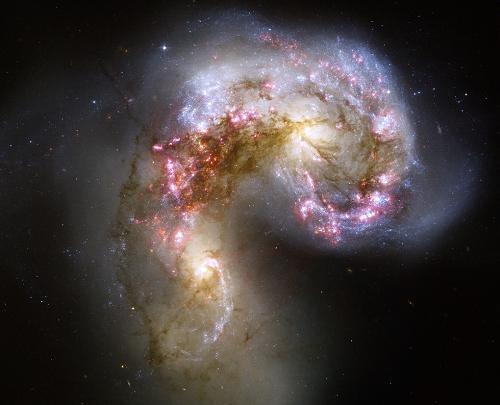A unique look at the process of creating superclusters in a collision between galaxies captured by the Hubble Space Telescope

This fresh image from the Hubble Space Telescope is of the Antennae Galaxies, the clearest image yet of this pair of merging galaxies. Billions of new stars were formed during the collision. These dense and bright regions are called super hothouses of stars.
The two galaxies began to converge several hundred million years ago, making the Antennae Galaxy one of the youngest examples of a pair of colliding galaxies. Almost half of the bright objects in the united galaxy are from young clusters each containing tens of thousands of stars. The orange clumps on the left and right of the center of the image are the two cores of the original galaxies, and they contain mostly old stars and huge trails of dust, visible in brown in the image. Both galaxies are dotted with bright blue regions of star formation surrounded by glowing hydrogen gas, visible in the pink image.
The image allows astronomers to better distinguish between the stars and the supercluster of stars formed in the collision between the two galaxies. By dating the clusters in the image, the astronomers discovered that only 10% of the new superclusters will survive beyond the age of 10 million years. Most of the clusters formed during the collision will disappear, and their individual stars will become part of the smooth background of the larger new galaxy that will be formed. However, it is believed that about a hundred of the more massive clusters will collapse and become normal globular clusters, similar to the globular clusters found in the Milky Way.
The Antenna Galaxy got its name from the huge antenna-like arms that extend from the nuclei of both galaxies and are well visible in ground-based telescopes. These tidal tails were formed during the initial collision between the galaxies 200-300 million years ago. They provide us with a preview of what might happen when our Milky Way collides with the neighboring large Andromeda galaxy in a few billion years.
